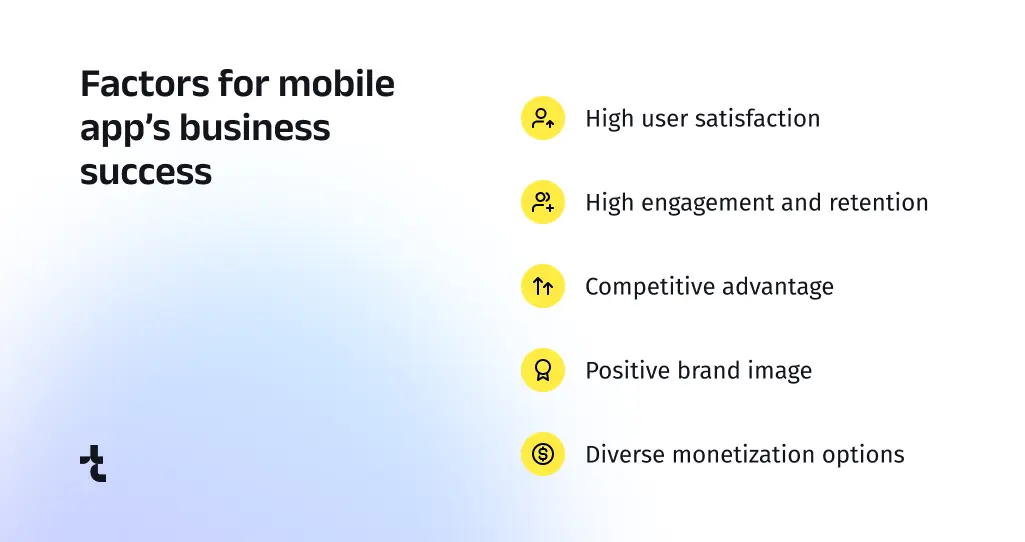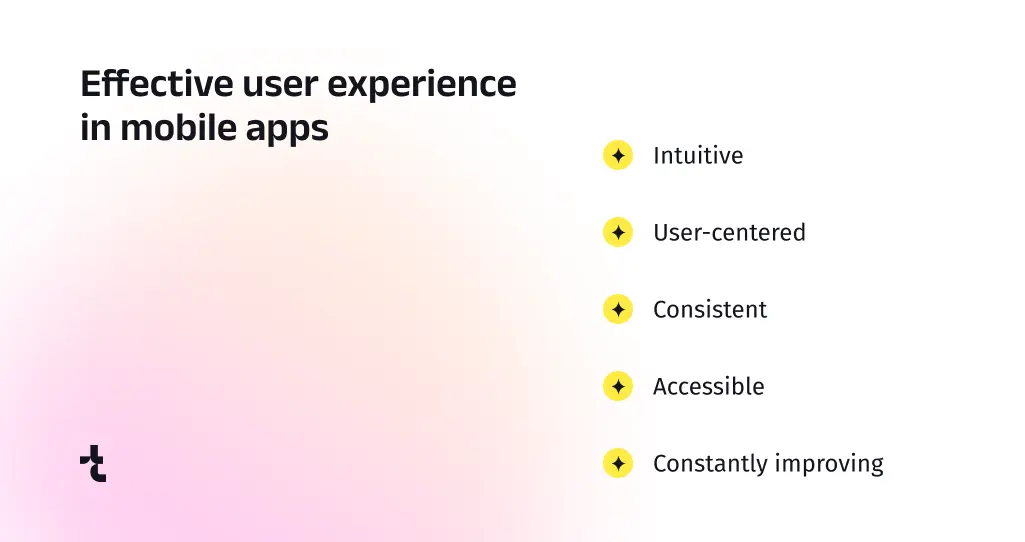Mobile App User Retention: ‘No’ to Annoying Alerts, ‘Yes’ to Thoughtful User Experience
April 10, 2024
In today’s bustling world of mobile applications, retaining users is a formidable challenge. With millions of apps vying for attention in app stores, offering the best user experience is key for sustaining user engagement and loyalty. From intuitive design to thoughtful notification strategies, every aspect plays its role in ensuring users keep coming back.
Here we’ll give some effective strategies and best features to enhance user experience and avoid annoying users with unnecessary alerts. But first, let’s see why user experience in mobile app user retention is even a matter.
The role of user experience in mobile app success
The impact of user experience (UX) on the overall success of a mobile app cannot be overstated. UX is the cornerstone upon which the success of a mobile app is built. It strongly influences user satisfaction, engagement, retention, and, ultimately, the app’s profitability. In reality, 90% of smartphone users will be more likely to buy something if their user experience is satisfying.
Let’s break down the essential business goals that a mobile app aims to achieve.
Higher user satisfaction
Simply, a positive user experience leads to higher levels of user satisfaction. When users find an app easy to use, intuitive, and enjoyable, they are more likely to have a positive perception of the app and its brand. Satisfied users are more likely to recommend the app to others and become loyal advocates, adding to its success through word-of-mouth promotion. Besides, user-friendly mobile apps enjoy five-star ratings in digital storefronts as a result of extreme user satisfaction.
Higher engagement and retention
Engaging users and retaining them over time is essential for a mobile app’s success. A well-designed UX keeps users coming back by providing value, meeting their needs, and offering an exclusive experience. Features such as personalized recommendations, intuitive navigation, and gamification elements can enhance mobile app user retention and encourage regular usage.
Differentiation and competitive advantage
In a crowded marketplace where numerous apps compete for users’ attention, a superior user experience can set an app apart from the competition. Apps with intuitive design, smooth performance, and thoughtful features are likelier to stand out and attract users in such circumstances. A unique, or just flawless, user experience can become a key differentiator that gives an app a competitive edge over others in the same category.
For example, IBM’s Watson AI has been used to predict and prevent IT incidents before they impact users. Watson analyzes vast amounts of operational data, identifies unusual patterns, and alerts teams to potential issues so that they can act before users are affected.
Positive brand perception
User experience directly influences how users perceive a brand. A good user experience creates a favorable impression of the app’s brand and reflects positively on the company behind it. Conversely, a poor user experience can tarnish a brand’s reputation and lead to negative associations. Investing in UX design demonstrates a commitment to quality and user satisfaction, which in turn enhances brand credibility and trustworthiness.
Let’s also quickly review how Generative AI, particularly its ability to process text and give user-friendly workable output, can optimize the work of DevOps teams.
Diverse monetization opportunities
A well-designed user experience can open up monetization opportunities for mobile apps. By creating a frictionless user journey and understanding user behavior, app developers can identify opportunities for in-app purchases, subscriptions, advertising, or other revenue streams. A positive user experience increases the likelihood of users engaging with these monetization features and generating revenue for the app.
So, UX plays a critical role in a mobile app’s overall success by driving user satisfaction, engagement, retention, differentiation, brand perception, and monetization. Investing in UX design and prioritizing user needs throughout the development process are essential strategies for creating a successful mobile app that delights users and achieves its business objectives.
While you can use different technologies, tools, or features to reach the goal of app user retention, there are fundamental rules to follow when planning your app’s UX.
5 Components of effective user experience in mobile apps
UX encompasses every aspect of how users interact with an application, from the moment they download it to every click, swipe, and tap they make while using it. Here’s a closer look at what it entails:
1. Intuitive design
Intuitive design is about making the user interface (UI) easy to understand and navigate. It involves using familiar patterns and conventions that users are accustomed to, such as placing navigation menus where users expect them or using standard icons for common actions. An intuitive design reduces the learning curve for users and allows them to accomplish tasks effortlessly.
2. User-centered approach
A user-centered approach means putting the needs and preferences of users at the forefront of the design process. It involves conducting user research to understand the target audience, their goals, pain points, and behavior patterns. By gaining insights into user motivations and challenges, designers can create solutions that address real user needs and deliver value.
3. Consistency across platforms
With users accessing apps across various devices and platforms, maintaining consistency in design and functionality matters much for a great experience and app user retention. Whether users are using the app on a smartphone, tablet, or desktop, they should encounter a consistent look and feel, as well as consistent interactions and features. Consistency instills confidence in users and enhances usability.
4. Accessibility
Accessibility ensures that the app is usable by people of all abilities, including those with disabilities. Designing with accessibility in mind involves making content perceivable, operable, and understandable for users with different abilities. This may include providing alternative text for images, maintaining color contrast for readability, and implementing keyboard navigation for users who cannot use a mouse.
5. Feedback and iteration
Finally, user experience is an iterative process that involves gathering feedback from users and continuously improving the app based on that feedback. At the end of the day, it’s all for them. This feedback can be collected through user testing, surveys, analytics, and user reviews. Keep listening to user feedback and iteratively refining the app so that you can address usability issues, fix bugs, and enhance features to meet user needs better over time.
In essence, understanding user experience is about empathizing with users, anticipating their needs, and designing solutions that make their interaction with the app efficient, easy, and enjoyable. Prioritizing user experience throughout the development process lets app developers create apps that users love and keep coming back to.
Another rule that deserves a highlight while discussing mobile app user retention is how to manage user notifications. In a world full of social media noise, information can be either helpful or completely harmful. Each notification is a distraction that can damage the quality of life. In the next section, we’ll explore how to make sure your app knows the essential boundaries.
How to avoid notification overload for app user retention
Again, while notifications can be a powerful tool for engaging users, bombarding them with irrelevant or excessive notifications can have the opposite effect. The three things that you need to keep in mind while setting up notifications are relevance, frequency, and consent. Follow these tips to adhere to all of them:
- Relevance: Only send notifications that are timely and relevant to the user. Personalize notifications based on user preferences and behavior to increase their impact.
- Frequency: Avoid overwhelming users with too many notifications. Strike a balance between staying top-of-mind and respecting users’ attention. Allow users to customize notification preferences to tailor their experience.
- Consent and opt-out options: Make sure to request permission and provide easy opt-out options for notifications. Respect users’ preferences and refrain from sending notifications to those who have opted out.
Remember, empathy starts with cherishing one’s well-being, so be ready to integrate this idea into your functionality. To help you start with making your app as effective as possible on the way to achieving app user retention goals and making them return for more, we’ve got some ideas of the particular features that already help thousands of apps shine in the app stores.
10 features that help boost UX and app user retention
These are ten real-life examples of effective UI/UX strategies that have helped popular apps of different types (you’ve likely used yourself) and the apps our teams have worked on at Timspark achieve successful mobile app user retention.
1. Visually appealing, intuitive navigation
A huge share of the popular social media success lies in their visually appealing design and intuitive navigation. The clean and simple interface encourages users to explore, engage with content, and spend more time on the platform.
Even if your app doesn’t include social interaction, the clarity communicated by user-friendly apps like Instagram or TikTok is something to borrow straightaway because 52% of users don’t appreciate bad aesthetics and never return.
2. Gamification
Many educational companies incorporate gamification elements into their learning apps. Thus, users are motivated to continue learning through a rewarding experience, earning points, and progressing through levels, which enhances engagement and app user retention.
Although learning and gaming apps are the first to use this strategy, you may find banking, investment, wellness, and other types of apps taking advantage of it, too. Some banking apps even give bonuses for a successful KYC verification completion or other important user milestones.
3. Swipe gestures for user interaction
We all know how mobile dating has been changed by introducing the swipe gesture for liking or disliking profiles. This simple and intuitive interaction has become synonymous with the apps, contributing to their widespread adoption and user retention.
Again, you don’t have to offer a dating app to leverage the feature. Swiping has become as common as the button click, but still feels fresh and super friendly when used in other types of apps.
4. Streamlined booking process
Delivery and riding apps’ success is partly attributed to their streamlined and user-friendly booking process. The apps usually minimize user input and provide a smooth experience, from choosing a ride and payment options to applying promo codes, chatting with drivers, and more. This greatly encourages repeat usage and fosters mobile app user retention without any doubt.
5. Personalized recommendations
Many streaming platforms excel at app user retention exclusively through personalized recommendations. The apps use algorithms to analyze viewing, listening, reading, or other interaction history and suggest content tailored to individual preferences, keeping users engaged with relevant and appealing shows, songs, books, and other content.
On the company side, effective mobile personalization reduces service delivery costs because the staff doesn’t have to manage irrelevant requests.
6. Simple and reliable messaging
Many companies prioritize simplicity and reliability in their messaging apps. The straightforward user interface, coupled with reliable messaging features, makes sure users continue using the app as their preferred communication platform. Lately, messengers have set up a new trend of putting reactions to messages instead of replying to them. Apparently, a message is now a piece of content, too, and you can think of the elements that users may put reactions to within your app.
7. Community-driven navigation
Traffic tracking apps are a good example of leveraging a community-driven approach to navigation. There, users contribute real-time data on traffic, accidents, and road conditions, creating a dynamic and reliable navigation experience that keeps users actively participating and using the app regularly.
If your app’s audience is a tight community and strongly relies on real-life updates, you might want to consider implementing a community-driven navigation.
8. Easy cross-platform experience
Again, coming primarily from streaming platforms, a spotless cross-platform experience allows users to switch between devices without interruption. Consistency in design and features across devices enhances user convenience and encourages prolonged usage. That’s why users keep coming back to the streaming apps they’ve been using for a while and have a hard time switching to a different one, even at a lower price.
Due to fierce competition, banking apps have also become more sophisticated in user experience. The cross-platform trend has made many banking organizations develop digital wallets that even tourists would find easy to use in a new location.
9. Ephemeral content and filters
Some messenger and social apps’ success is attributed to their unique approach to ephemeral content and creative filters. These apps create a real sense of urgency and risk of missing out forever because the content users create is only there for a while. This approach almost guarantees regular check-ins and in-app interaction when used as part of user retention strategies mobile app utilizes.
10. Goal tracking and progress visualization
Last but not least, mobile apps just need to make sense of all the actions and data collected from users. Goal tracking and progress visualization features, that you might use in wellness and fitness apps, are handy to promote user retention. The apps that offer these encourage users to set goals, track their activities, and visualize their progress over time to provide a motivational and engaging experience.
These examples showcase how successful mobile apps strategically employ UI/UX principles to enhance user retention. By focusing on intuitive design, personalization, gamification, and user-centric features, many brands have built lasting connections with their customers and user retention strategies mobile app needs.
Are you sure your app does a great job retaining users?
User attention is a scarce commodity, so prioritizing user experience is essential for retaining mobile app users. Does your app focus on intuitive design, personalization, performance optimization, and thoughtful notification strategies? As empathetic app developers, we at Timspark can create a seamless user experience that keeps users coming back for more as we work on your product at all stages, from ideation to maintenance. Remember, happy users are loyal users, and investing in their satisfaction is key to long-term success in the mobile app industry.




